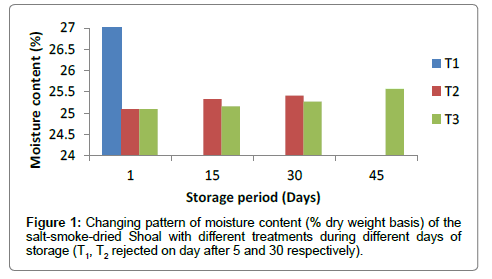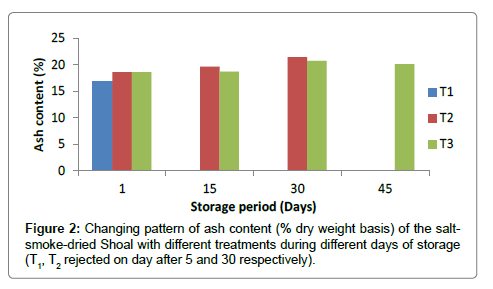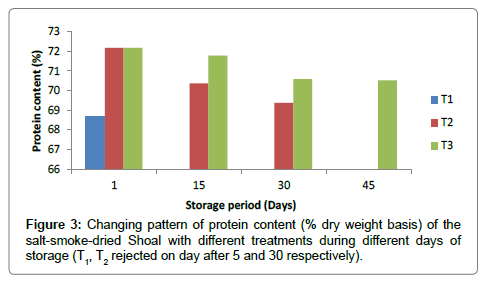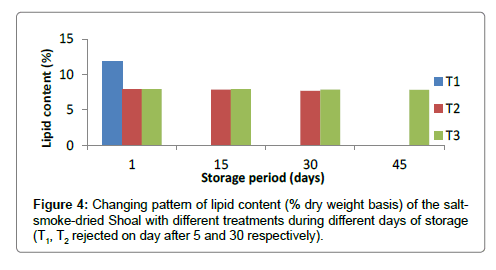Research Article Open Access
Effect of Storage Temperature on the Quality and Microbial Content of Salt-Smoke-Dried shoal (Ophiocephalus striatus
Chakroborty T* and Chakraborty SCDepartment of Fisheries Technology, Bangladesh Agricultural University, Bangladesh
- *Corresponding Author:
- Chakroborty T
Department of Fisheries Technology
Bangladesh Agricultural University
Bangladesh
Tel: +88-01732841801
E-mail: tonmoyfs11.bd@gmail.com
Received Date: January 17, 2017; Accepted Date: January 31, 2017; Published Date: February 05, 2017
Citation: Chakroborty T, Chakraborty SC (2017) Effect of Storage Temperature on the Quality and Microbial Content of Salt-Smoke-Dried shoal (Ophiocephalus striatus). J Fisheries Livest Prod 5: 217 doi: 10.4172/2332-2608.1000217
Copyright: © 2017 Chakroborty T, et al. This is an open-access article distributed under the terms of the Creative Commons Attribution License, which permits unrestricted use, distribution, and reproduction in any medium, provided the original author and source are credited.
Visit for more related articles at Journal of Fisheries & Livestock Production
Abstract
The research was carried out to evaluate the comparative changes of quality and microbial content of salt-smokedried Shoal (Ophiocephalus striatus) kept under different condition using standard method of analyses. The fish in three treatments T1, T2 and T3 were denoted controlled, ambient (22-28°C) and refrigeration (40) condition respectively. The controlled fillets were only sun-dried without salting and smoking and kept at ambient temperature whereas, T2 and T3 represented the fish at ambient and refrigeration storage respectively. The shelf-life in T1 treated dried fillet was up to 5 days after preparation and T2 treated fillet 30th whereas the shelf life in T3 treated products was excellent up to 45 days period. It was found that the moisture, ash, protein and lipid, standard plate count (SPC) was 27.05%, 11.81%, 50.09%, 8.64% and 2.96 × 104 CFU/g for treatment T1. The same parameters during 30 days observation for treatment T2 ranged from 25.09-25.41%, 13.92-15.98%, 54.07-51.74%, 5.94-5.81% and 2.12 × 104 - 1.04 × 108 CFU/g respectively whereas during 45 days observation for treatment T3 25.09-25.57%, 13.92-15.98%, 54.07-52.49%, 5.94-5.82% and 2.12 × 104 - 2.8 × 107 CFU/g respectively. Analyzing all the quality parameters of the salt-smoke-dried Shoal it was revealed that the quality was still excellent and no indicative quality reduction occurred in Shoal kept at refrigeration temperature (treatment T3) during 45 days of storage.
Keywords
Quality; Microbial content; Shoal; Salt-smoke-dried
Introduction
The causes of fish spoilage are bacterial activity, autolysis, oxidation and most commonly by combination of these which bring about very noticeable changes in the texture, flavor, odor and general appearance of the product. To enhance the shelf life of fish different fish curing methods has been practiced in Bangladesh for a long time. Drying as a fish preservation technique had been practiced perhaps longer than any other food preservation technique. However, drying together with saltsmoking is another method of fish preservation. Salt-smoke-drying of fish provides the product a desirable taste, odor, flavor, color, longer shelf-life, and also prevents spoilage of product by reducing the water activity. Therefore, salt-smoke-drying may be considered another important aspect of fish preservation.
Shoal (Ophiocephalus striatus) is a popular air breathing fresh water snake head fish and an important food fish in its entire native range, and has considerable economic importance. Cream extracts of Shoal fish tissues contain high levels of arachidonic acid, a precursor of prostaglandin, essential amino acids (particularly glycine), and polyunsaturated fatty acids necessary to promote prostaglandin synthesis. This fish also contains polyunsaturated fatty acids (PUFA), which play important roles in cardiovascular system to reduce the risk of heart attack.
Lean fish like - Shoal is suitable for sun-drying. For this reason, the fish Shoal was chosen for the preparation of salt-smoke-dried products due to high palatability and marketability of traditional dried products of Shoal and in future it would be a very popular food item among the people of Bangladesh. Therefore, in the present study the biochemical and microbiological analysis were carried out to assess the qualities of smoke-dried products of Shoal.
Materials and Methods
Fresh Shoal (Ophiocephalus striatus) collected from the local market for preparation of salt-smoke-dried products. The fishes for salt-smoke - drying divided into three treatments viz. T1, T2 and T3. For T1 the fishes were considered as controlled where no salt-smoke was treated and the product was kept at ambient temperature. In treatment T2 and T3 the salt-smoke-dried fish was kept at ambient and refrigeration temperature for studying shelf-life at varying length of times. After collection the fresh fish were weighed, dressed, filleted followed by washing. The fillets for T2,T3 were brined (≈25% brine) followed by air drying, partial smoking (30 minutes at 53°C), sun drying (21 h in the ring tunnel) and packaged for shelf-life study. Two fishes were kept for control condition (T1). For treatments T2 and T3 a total of 6 fishes were selected randomly for salt-smoke-drying.
For biochemical analysis AOAC (1990) method was followed for determination of fresh fish and salt-smoke-dried fish composition. Microbiological analysis during shelf life study of fish was done by applying consecutive decimal dilution technique using spread plates [1].
Results and Discussion
Changes in moisture content
The moisture content of fresh Shoal was 78.51% while partial smoking slightly decreased the moisture content to 74.50%. The moisture content of sun dried controlled fillet (treatment T1) where the filet was not salted and smoked, was 27.05% and salt-smokedried (treatment T2 and T3) fillet was 25.09%, 24.51% respectively. The moisture content of the product at ambient temperature (treatment T2) was 25.41% during 30 days storage and refrigerated temperature (treatment T3) was 25.57% during 45 days storage. However, there was no significant increase observed during different storage treatment (Figure 1). Increases in moisture content could be attributed to the difference in the moisture of the salt-smoke-dried fish relative to the surroundings.
Nketsia and Sefa-Dedh [2] found the moisture content of the smoked fish products range from 11.70% to 69.20% Similarly, Kosygin [3] showed that moisture content ranged from 10.30-29.90% in six hot smoked fishes. Experiment conducted by Reza [4] found that the moisture content of dried products ranged from 18.0 to 29.8%. Similarly, Siddique et al. [5] determined the moisture content marine dried products was in the range of 13.81%-34.99%.
Mansur, et al. [6] reported that the moisture content of dried Indian major carps ranged from 19.17 to 23.99%. Similarly, Flowra, et al. [7] showed that the moisture content of dried fishes ranging from 14.06 to 24.58%. However, the present results of salt-smoke-dried products in Shoal also agreed with the above studies.
Changes in ash content
The ash content of fresh Shoal fillet was 0.89% whereas smoking of fish was slightly increased the ash content to 2.83%. After sun drying the ash of controlled shoal fillet (treatment T1) was 13.92% (18.59%) whereas the ash content of salt-smoke-dried (treatment T2 and T3) fillet was significantly increased 11.81% (16.88%) on the 1st day before storage. The values in the parenthesis are the weight in dry wt. basis. On the 30th day observation the ash content Shoal was 15.98% (21.42%) for treatment T2. On the other hand, during 45 days the ash content of Shoal was 14.98% (20.12%) for treatment T3. In this experiment it was observed the ash content increased after salt-smoke-drying because the salt increased from raw fishes had large amount of inorganic salt compared to fresh samples (Figure 2).
Mohsin [8] reported that the initial ash content of Pangas fillet was 1.25%. Likewise, Chakraborty [9] found that in smoking process, the ash content was found to be 1.43, 1.45 and 1.50%. In another experiment Debnath et al., [10] found that initial ash content of Pangas fish fillet was 1.02% and concluded the ash content values of smoked product ranging from 1.15-1.91% during different storage condition.
Experiment conducted by Gopal [11] showed that the medium hot smoked Pangus (Pangus hypophthalmus ) fish had ash content values ranging between 1.39% and 1.60% in different days of observation of the smoked product in refrigeration storage.
Study conducted by Kosygin, et al. [3] on six smoked hill stream fishes and reported that ash content on dry basis ranged from 0.02% to 7.00%. Similarly, Islam [12] determined that the ash content of solar tunnel dried products ranging from 11.95%-16.58%. Likewise, Reza [4] found that the lipid content of dried products ranged from 15.5 to 26.84. This experiment with Shoal provided more or less similar result with the findings above.
Changes in protein content
The protein content of fresh Shoal was 17.39% and after partial smoking the protein was little increased to 18.26%. Besides, sun drying of Shoal in T1 treated showed a significantly increased value of the protein content of was 50.09% (68.67%) whereas, for salt-smoke dried (treatment T2 and T3 ) fish the protein content was 54.07% (72.18%) during the 1st day before storage. The values in the parenthesis are the weight in dry wt. basis. On the 30th day observation the protein content of Shoal was 51.74% (69.37%) for treatment T2. On the other hand, during 45 days the protein content of Shoal was 52.49% (70.52%) for treatment T3.
Thus, no significant changes were found in protein content of saltsmoke- dried Shoal during different storage time (Figure 3).
In an experiment on sun dried salted Hilsa products Chakraborty, et al. [9] reported that in protein content increased from 17.06% to 35.00%. This was due to a significant loss of moisture and high uptake of salt by fish muscle. Likewise, Nketsia and Sefa-Dedeh [13] determined the protein content of the smoked fish products ranging from 71.5% to 4.5%. Study conducted by Kosygin [3] found that protein content on dry basis ranged from 74.75% to 79.25% in six smoked hill stream fishes. In another experiment with Thai Pangas (Pangasius hypothalamus), Debnath, et al. [10] reported that initial protein content values of smoke product was 17.27% and found the protein content values of smoked product ranging from 20.27-22.01% during different storage condition.
Besides, Mansur, et al. [14] reported that the protein content of tent dried fishes ranged from 60.07 to 72.51%. Similarly, Islam [12] showed that the protein content of solar tunnel dried products ranging from 58.13 to 68.49%. Likewise, Reza [4] found that the lipid content of dried products ranged from 42.51 to 56.58%. Similarly, Hasan [15] determined the protein content of solar tunnel dried products was in the range of 49.32%-65.30%. Thus, the present study of salt-smokedried Shoal showed no significant changes in protein content which was more or less similar to the studied with other authors.
Changes in lipid content
The lipid content of fresh Shoal was 1.72% while smoking of fish was slightly increased the lipid content to 2.67% whereas sun drying increased the lipid content of controlled fish (treatment T1) which was 8.63% (11.85%) and salt-smoke-dried (treatment T2 and T3) was 5.94% (7.93%) on the 1st day before storage. The values in the parenthesis are the weight in dry wt. basis. On the 30th day observation the lipid content Shoal was 5.81% (7.68%) for treatment T1. On the other hand, during 45 days the lipid content was 5.82% (7.82%) for treatment T3. However, no significant change in lipid content was observed during the storage period (Figure 4).
This small change might be due to oxidation and hydrolysis of some of the lipid fraction to other components. Study done by Nketsia and Sefa-Dedeh on smoked fish products and determined the lipid content of the ranged from 7.2% to 19%. Similarly, Debnath, et al. [10] reported that initial lipid content of pangas fillet was 10.64% and found the lipid content values of smoked product ranging from 9.26-10.60% during different storage condition.
Besides, Mansur, et al. [14] reported that the lipid content of tent dried fishes ranged from 6.43 to 14.99%. In an another experiment, Islam [12] showed that the lipid content of solar tunnel dried products ranging from 5.63 to 10.08%. Similarly, Reza [16] found that the lipid content of dried products ranged from 1.97 to 8.08%. Likewise, Hasan [15] determined the lipid content of solar tunnel dried products in the range of 11.96%-18.07%. The present study of salt-smoke-dried with Shoal also agreed with the above reports.
Microbial analysis
The bacterial load of fresh Shoal fillet was 7.5 × 105 CFU/g whereas, smoking of fish slightly decreased the bacterial load to 6.00 × 104 CFU/g. After sun drying the bacterial load of salt-smoke-dried (treatment T2 and T3) was 2.12 × 104 CFU/g and controlled fillet (treatment T1) was 2.96 × 10104 CFU/g, for during the 1st day of storage. On the 30th day observation the bacterial load was 1.04 × 1088 CFU/g for treatment T2. On the other hand, during 45 days the bacterial load was 2.8 × 107 CFU/g for treatment T3.
The total bacterial load in treatment T2 and T3 both for Shoal and Mirror carp were found to be increased significantly with the lapse of time and reached maximum at unacceptable limit and then it was considered as spoiled. In this study it was observed that the total bacterial load of salt-smoke-dried products were increased with increase in the duration of storage due to growth and multiplication of the microbes. As the duration of storage increased processed fish samples may absorb small amounts of moisture from surrounding atmosphere providing enabling environment for microbial growth. Smoking inhibits microbial growth in stored fish products.
Experiment conducted by Debnath, et al. [10] on smoked pangas and reported that initial bacterial loads of fresh pangas fillets 1.5 × 105 CFU/g and found that the bacterial load of smoked product ranging from 1.8 × 103-4.10 × 109 CFU/g during different storage condition. The bacterial counts are generally lower for smoked fish compared to fresh fish [13]. Salan, et al. [4] reported that the fish with microbial load >106 CFU/g is likely to be at the stage of being unacceptable from the microbiological point of view and unit for consumption which agrees with the present research work. Study conducted by Mansur, et al. [6] on sun-dried samples and revealed that the total bacterial count (TBC) ranged from 1.84 × 104 to 5.3 × 106 CFU/g and also highly varied among the species probably indicating the different degrees of spoilage by bacteria. Similarly, Nahid, et al. [17] found that smoke-dried freshwater small fish, Chapila (Gudusia chapra) and Baim (Mastacembelus pancalus) during storage at room temperature (26-31°C) the (Total viable count) TVC ranged from 1.8 × 103-2.3 × 106 CFU/g and 1.1 × 103-2.0 × 106 CFU/g respectively. This experiment with Shoal agreed with the findings of the above study.
Acknowledgement
The author acknowledges the BAU Research System (BAURES) for financial support of the present study. The author also expresses his sincere gratitude to Prof. Dr. Subhash Chandra Chakraborty for his scholastic guidance, invaluable advice during research.
References
- AOAC (1990) Official method of analysis. In: Horwitz W (ed.) Association of Official Agricultural Chemists (12thedn) Washinton DC.
- Nketsia T, Sefa-Dedeh S (2000) Quality attributes of cured fish in Ghana. Journal of Applied Science and Technlog (JAST), Vol. 5 (1&2): 148-155.
- Kosygin L, Lilabati H and Viswanath W (2001) Proximate composition of commercially important hill stream fishes of Manipur. India J of Fisheries 48: 111-114.
- Salan OE, Juliana AG, Marilia O (2006) Use of smoking to add value to salmoned trout. Braz Arch Biol Technol 49: 57-62.
- Siddique MAM, Akter M (2011) Changes of nutritional value of three marine dry fishes (Johnius dussumieri, Harpodon nehereus and Lepturacanthus savala) during storage. Food and Nutrition Sciences 2: 1082-1087.
- Mansur MA, Rahman S, Khan MNA, Reza MS, Kamrunnahar, et al. (2013) Study on the quality and safety aspect of three sun-dried fish. African Journal of Agricultural Research 8: 5149-5155.
- Flowra FA, Nahar, DG, Tumpa AN, Islam MT (2012) Biochemical analysis of Five Dried Fish species of Bangladesh. J zool Rajshahi Univ 31: 9-11
- Mohsin A (2008) Study of hot smoke curing Thai pangas (Pangasius hpophthalamus) at different coditions M.S. Thesis, submitted in the Department of Fisheries Technology, Bangladesh Agricultural University.
- Chakraborty SC (2003) A Study on proximate composition fresh water fishes of Bangladesh. Bangladesh J Fish 26: 23-26.
- Debnath SK, Chakraborty SC, Sharmin R, Nath PCD (2009) A study on the improved technique for the production of smoked Thai pangas (Pangasius hpothalmus). Intl J Biores 2: 47-50.
- Gopal S (2005) A study on the shelf life of smoked Thai pangas (Pangasius Hupothalmus) MS, Thesis, submitted in the Department of Fisheres Technology, Bangladesh Agricultral University, Mmensingh, p: 71.
- Islam S (2001) A comparative study on the nutritional and food quality aspects of some traditional sun dried and solar tunnel dried marine fish products, MS Thesis, Department of Fisheries Technology, Bangladesh Agricultural University, Mymensingh, Bangladesh, pp: 45-60.
- Oku, Ikpebivie , Amakoromo, Rebecca, E (2013) Microflora of fresh and smoke-dried fish in Yenagoa metropolis, Nigeria. African Journal of Microbiology Research 7: 4451-4456.
- Mansur MA, Islam MN, Chalraborty SC, Chaity FA (1990) A comparative study in the traditional and solar tent dried fish. Bangladesh Journal of Fisheries 13: 33-39.
- Hasan MM (2006) Improvement of food quality of traditional dried small indigenous fish products using rotary dryer and solar tunnel dryer, MS Thesis, Department of Fisheries Technology, Bangladesh Agricultural University, Mymensingh, Bangladesh, p: 126.
- Reza MS (2002) Improvement of food quality of traditional marine dried fishery products using solar tunnel drier. M. Sc. Thesis, Department of Fisheries Technology, Bangladesh Agricultural University, Mymensingh, Bangladesh, p: 136.
- Nahid MN, Latifa, GA, Farid, FB and Begum M (2014) Proximate composition of salted smoke-dried and salt-garlic treated smoke-dried chapila (gudusia chapra; hamiltonbuchanan, 1822) fish stored at room temperature. Bangladesh J Zool 42: 205-209.
Relevant Topics
- Acoustic Survey
- Animal Husbandry
- Aquaculture Developement
- Bioacoustics
- Biological Diversity
- Dropline
- Fisheries
- Fisheries Management
- Fishing Vessel
- Gillnet
- Jigging
- Livestock Nutrition
- Livestock Production
- Marine
- Marine Fish
- Maritime Policy
- Pelagic Fish
- Poultry
- Sustainable fishery
- Sustainable Fishing
- Trawling
Recommended Journals
Article Tools
Article Usage
- Total views: 4350
- [From(publication date):
March-2017 - Mar 29, 2025] - Breakdown by view type
- HTML page views : 3396
- PDF downloads : 954




